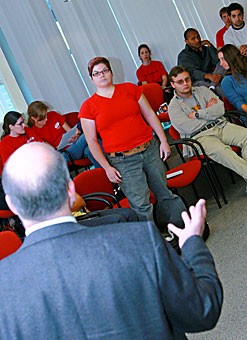The UA may be able to offer students a dental insurance plan next fall, but optical insurance and additional prescription coverage will not be offered, UA officials said at a health insurance forum yesterday.
Provost George Davis and Dr. Harry McDermott, executive director of Campus Health Service, spoke with students about the UA’s health insurance offerings at a forum hosted by the Graduate and Professional Student Council in the Student Union Memorial Center.
Costs for adding a dental plan are being considered and are estimated by the UA’s consulting firm to cost an additional $240 a person per year, McDermott said.
The UA will be evaluating health insurance proposals this spring because the health insurance plan is reassessed every five years, McDermott said.
Students are concerned about the lack of dental and prescription plans, the affordability of dependent coverage and the overall cost of the plan, said Paul Thorn, GPSC president.
The push for health insurance reform came as the result of a survey of peer institutions released in September, which Thorn said put the UA at the bottom of the list in terms of benefits offered.
The UA provides health insurance to graduate teaching and research assistants as a benefit of employment, but the added costs of dental insurance could be a lot for the university, McDermott said.
Dependents’ health coverage was also a concern for some students at the forum, but McDermott said the student health insurance plan was developed to cover students, not their children or spouses.
Campus Health is not considering an optical plan for students because students can find optical care locally for the same price as would be offered by Campus Health, McDermott said.
Additionally, Campus Health is not looking to add additional prescription benefits because discounts and pharmaceutical company programs already exist for students who qualify for them, McDermott said.
Nicole Quackenbush, a graduate student in English, said since she was diagnosed with multiple sclerosis, she has prescriptions that cost her about $23,000 per year.
The costs were significant enough that she had to consider either quitting her graduate teaching assistantship to go on state medical assistance or to not take her medications and continue in her educational and teaching endeavors, Quackenbush said.
Mary Adde, a physiological sciences graduate student, asked Davis and McDermott why the UA cannot offer prescription and dental coverage to students when comparative universities can.
Davis said that although the UA wants to attract graduate students, the university cannot fund all of its students’ needs.
“”We’re behind our peers in a number of things,”” Davis said, referring to issues such as faculty retention.
But the UA is not behind in providing funding opportunities for graduate students, Davis said.
Adde said the UA should be ashamed at the fact that students have to apply for prescription-assistant plans.
“”Are you ashamed?”” she asked McDermott and Davis.
Davis said Arizona should be ashamed it is nationally last in student financial aid. The lack of prescription plan is symptomatic of a larger issue, he said.
McDermott said the plan is not perfect, but the UA is looking for ways to improve it.
Other questions involved whether separating the graduate students from the undergraduates would improve the ability to get benefits, about whether graduate teaching assistants are employees or apprentices and how the UA’s premiums compare with peer universities.
McDermott said separating the undergraduates from the graduate students would reduce the pool of participants and drive up the cost.
Davis said graduate assistants are students first and employees second, when it comes to benefit eligibility for the regular employee health plan.
Thorn said the premiums compare in the “”middle of the pack”” and that the value of the premiums is reasonable.









